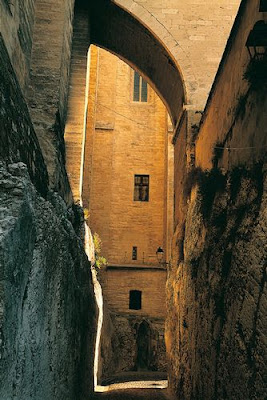In the 14th century, this city in the South of France was the seat of the papacy. The Palais des Papes, an austere-looking fortress lavishly decorated by Simone Martini and Matteo Giovanetti, dominates the city, the surrounding ramparts and the remains of a 12th-century bridge over the Rhone . Beneath this outstanding example of Gothic architecture, the Petit Palais and the Romanesque Cathedral of Notre-Dame-des-Doms complete an exceptional group of monuments that testify to the leading role played by Avignon
In 1309 the Frenchman Bertrand de Got, who had been elected and crowned Supreme Pontiff in 1305, refused to go to Rome , choosing instead to install himself temporarily in the Dominican Convent at Avignon Rome
Clement's successor, John XXII (1316-34), moved to the former bishop's palace, which ne converted into a Papal Palace Ile-de-France New Palace
Avignon had been sold to Clement VI in 1348 by Queen Joan of Naples and Sicily, and it was to remain the residence of the Italian Papal legates for nearly four hundred years after the Papacy had returned to Rome, until they were expelled at the time of the Revolution, when the people of Avignon, which had benefited markedly from its long association with the Papacy, opted to join France. In 1793 the Convention decided to demolish this "Bastille du Midi," but the massive building defied their efforts. It passed to the ownership of the town in 1810,and eight years later was put at the disposal of the Minister of war, Who used it as a barracks until 1906, when it was returned to the town.










Niciun comentariu:
Trimiteți un comentariu